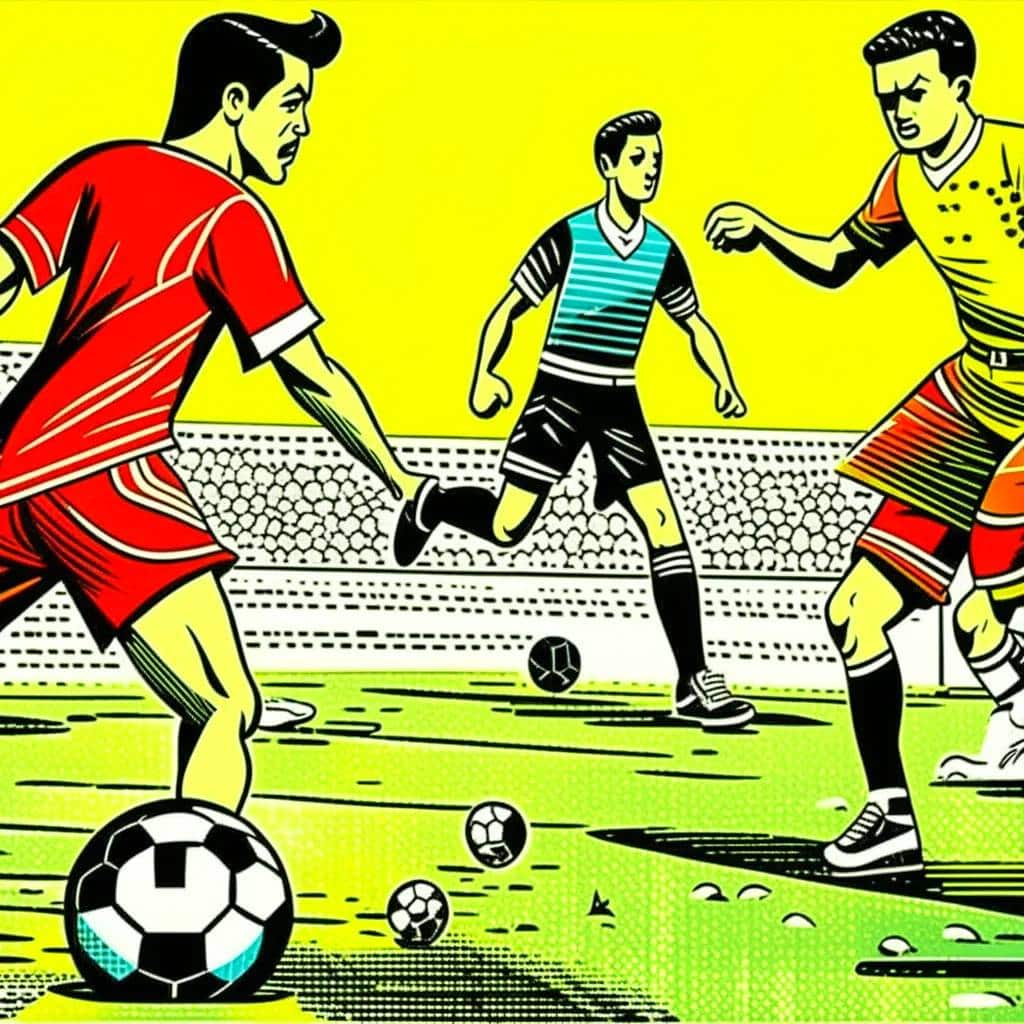Table of Contents
Ever wondered how the UEFA Champions League came about and why it’s such a big deal? Read on to learn exactly how this premier club competition started and how it evolved to what it is today. From its creation in 1955 by the Union of European Football Associations (UEFA) to the new ‘Swiss model’ format in 2024–2025 season, the UEFA Champions League history is filled with memorable moments, record setting performances, and comebacks that you’ve probably never seen before and likely ever will again in European football. Get ready to see the financial growth, global reach, tactical growth, and club infrastructure growth that was spurred because of this prestigious tournament.
Key Takeaways
- Find out the history of the UEFA Champions League dating back to 1955
- See how the tournament’s evolved from a simple knockout format to adding group stages and the ‘Swiss format’?
- Explore the impact of the Champions League on financial growth, global prestige, tactical innovation, and infrastructure growth
Origins and Early Years
The UEFA Champions League, or what it was originally called the European Champions Club’s Cup, was founded in 1955 by the Union of European Football Associations (UEFA) to standardize a continental club competition. They wanted one tournament to rule them all to showcase the best football clubs in Europe and definitively crown a champion. Until this point, there was no centralized club football competition at a European level as the domestic and regional tournaments were all independent of each other.
The very first European Cup was played in 1955–1956 and had 16 teams playing in the tournament: the champion of their respective national leagues. The very first game ever was Sporting CP of Portugal vs Partizan of Yugoslavia, which ended in a 3–3 draw. What an exciting start to the very first European Cup! This first instance of the European Cup would go on to standardize a lot of the traditions and dynamics of what we now know as the UEFA Champions League.
Real Madrid’s Early Dominance
Real Madrid won the first European Cup in 1956, and won it again in 1957, 1958, 1959, and 1960. They were unstoppable back then. I’m not even mad, I’m just impressed.
The 1959–1960 final was especially memorable, because that year Real Madrid played Eintracht Frankfurt at Hampden Park. And it was a pretty high-scoring match, with Real Madrid winning by 7 goals to 3. That’s the highest-scoring match in European Cup finals history. This high-scoring match generated a lot of buzz and interest in the European Cup, and helped ensure its future popularity as must-watch content for European soccer fans.
Real Madrid’s early dominance of the European Cup is a huge part of why it’s the premier club soccer competition in Europe today. Real Madrid’s dominance in these early years lent the tournament huge amounts of credibility and prestige, which allowed it to grow into the UEFA Champions League that’s such a part of our lives today.

Evolution of Tournament Format
Introduction of Group Stage
Before 1991, the Champions League (back then, it was called the European Cup) used to have a knockout format, where you lose one game and you’re out. This was later thought to be unfair because you had situations where high quality teams would get eliminated early even though they probably could’ve gone far. So to fix that, UEFA added a group stage in 1991 where high quality teams can play more games. Now, instead of being a one and done, teams get a few games to show their quality against a few different opponents. This not only increased the total number of games played, but also decreased the chance that a heavy weight team would get eliminated early, leading to a more fair and competitive landscape.
Expansion and Rebranding
In 1992, the European Cup had a big makeover. Both the format and branding of the tournament was changed. It was renamed to the UEFA Champions League, meaning that it’s the highest tournament for clubs to qualify for in all of Europe. With the rebranding came the new format: it would still have a group stage to begin, but with one big addition – a knockout stage. After the round-robin group stage, the top teams in each group would play a series of two-legged matches where the losers would be eliminated, until there were 2 teams left. They would meet in a 1‑game final, and the winner would be the European Champion. This format, combining the group stage with the increased participation with the knockout rounds and its drama, is the Champions League today.
Inclusion of Non-Champions
Before 1997, the Champions League (formerly known as the European Cup), was only for the domestic league champions of each European country. But in 1997, a huge change was made to where domestic league runners-up could also play in the tournament. This change was made to let more teams participate, and to make the games even more competitive overall. By allowing not only the champions of the domestic league to play, but also the runners-up, the Champions League was able to attract even more talented clubs, which, in the end, made the games even better and more fun.
Swiss Model (Future Change)
Looking ahead to the 2024–25 season, the UEFA Champions League is getting a huge makeover with the ‘Swiss model’ format. With this new format, 32 teams will expand to 36 teams, and all 36 teams will duke it out in one massive league. Instead of the traditional group stages, every team will play all their 10 opponents in a round-robin style. The top 8 teams in the league will auto-qualify to the round of 16, and teams 9–24 will play in a two-legged playoffs against each other to determine the last 8 teams in the round of 16. With this new format, fans can expect more games, a more balanced and fair competition, and a new seeding process that doesn’t just give the best teams an easy group to play in. By using a Swiss model, the Champions League is hoping to be much more entertaining and engaging for fans, while still making sure the best teams end up in the knockouts.
Iconic Moments and Matches
The UEFA Champions League, the ultimate club soccer competition in Europe, has given us countless memorable moments that’ll be ingrained into your hearts and minds for the rest of your life. It’s given us game after game of high-octane action that’s changed the way soccer is played, and is easily one of the most prestigious and engaging sporting events in the world.
Historic Finals
The Champions League final is always known as the stage for the ultimate showdown, where the best of the best come together to decide the best team in Europe. Two of these finals stand out as true milestones in the competition. The final in 1999 between Manchester United and Bayern Munich is a testament to football’s sheer unpredictability and drama. With Bayern leading 1–0 deep into injury time, Manchester United, through the heroics of Teddy Sheringham and Ole Gunnar Solskjær, scored two late goals to steal victory from the jaws of defeat, in one of the most iconic comebacks in football history. This turnaround not only epitomized the team’s never-say-die attitude, but also served as an emotional reminder that the game isn’t over until the final whistle is blown.
Similarly, the 2005 Champions League final between Liverpool and AC Milan will always have a special place in the annals of the competition. Down 3–0 at halftime, Liverpool had an impossible task in front of them. However, they managed to claw their way back to equalize the game 3–3 and then win the game on penalties, an achievement now immortalized as the ‘Miracle of Istanbul’. This historic comeback, orchestrated by the tactical genius of Rafael Benítez and the sheer willpower and determination from the Liverpool players, has cemented the game as one of the greatest comebacks in the history of the sport, captivating global audiences and solidifying the Champions League’s reputation as the home for high drama and incredible excitement.
Record-Breaking Performances
The Champions League has also been a stage for players to make names for themselves. And one of the most famous names is with the incredible amount of goals scored for the Champions League, Cristiano Ronaldo is the #1 all-time top scorer in the Champions League with 120 goals! As of 2018. Ronaldo’s uncanny ability to put the ball in the back of the net, combined with his consistent and adaptability, has made him a player that every year, dominates the competition, and breaks record after record, and solidifies himself as a player that will forever be remembered in soccer history. He scores goals in so many ways, from long-ranged missiles to towering headers, and it’s absolute poetry for the eyes, leaving defenders and fans alike in awe, and cementing himself as one of the best finishers in the game, and a complete forward.
But the Champions League is also home to dominant teams. And no team was more dominant than the Real Madrid side from 2016 – 2018. Real Madrid won an unprecedented 3 Champions League titles in a row under Zinedine Zidane, and this speaks to one of the most dominant teams in modern soccer, and a team that’s able to perform at the highest level. This feat had been done before in the early days of the competition, but no one has been able to accomplish this in the modern era, and this was a time where Real Madrid became the undisputed kings of Europe, showing their mental fortitude, tactical flexibility, and depth of their squad.
Unforgettable Comebacks
The Champions League has also seen some of the most amazing, most improbable comebacks in sports history. One of the most famous ones is Barcelona’s amazing 6–1 win over Paris Saint-Germain in 2017 to overturn a 4–0 deficit in the first leg. This comeback, dubbed the ‘Remontada’, had the whole world talking and showed Barcelona’s relentlessness, adaptability, and most of all, the pure randomness of the Champions League. The fact that they were able to come back from such a seemingly insurmountable odds, and do it in the dying seconds of the game, made this one of the most memorable games in the history of the competition.
Similarly, Tottenham Hotspur’s comeback win against Ajax in the 2019 semi-finals at the very last minute shows just how relentless and how much of a roller-coaster the Champions League can be. Down 3–0 on aggregate, Tottenham was able to tie, then win the game at the very last second. This win sent Tottenham to their first-ever Champions League final and it was just another example of how much this competition can just suck you and not let you go, leaving fans on the edge of their seats. Another classic.
Impact on European Football
Financial Growth
The UEFA Champions League has become a massive cash cow for teams all around Europe. The sheer prize money and TV rights money that comes with it has single handedly transformed the economics of the sport. Teams who make it and advance in the tournament can earn large amounts of money, with the winner of the 2024 edition walking home with an 23.5 million Euros just from prize money. With that much cash injected, teams can go out and invest in players, invest in their facilities, overall just invest in themselves in ways that weren’t possible before. The Champions League in many ways is a stepping stone for teams to stabilize themselves financially, and to be able to compete at a high level both domestically and internationally. This in turn has created a ton of competition, with teams now able to offer more money in salaries and better facilities. The rich only get richer, and many teams have used the growth in money to attract top tier talent, build state of the art training facilities, and solidify themselves as one of the elite forces in European football.
Global Prestige
Winning the UEFA Champions League is like the holy grail for soccer clubs and it’s frequently even more prestigious and well-respected than just winning the domestic league for a lot of teams. The competition has turned into a worldwide event for the sport and there are hordes of fans from all corners of the globe that religiously follow their favorite teams. Winning the unique trophy is considered to be the ultimate feather in the cap and the winner club gets immediate global respect regardless of what country you’re from. Players that perform well in the Champions League are pretty much almost guaranteed to have their profiles raised significantly, and standout performances in the tournament are the root cause for many high-profile transfers and insane X,XXX% increases in market value. It’s the stage where the best players on the planet show their stuff and they can hereafter etch their legacy as the greats of all time. This global respect has consequently turned the Champions League into a cultural phenomenon, and the iconic branding, the atmosphere and the theatrics of the tournament captivates people from around the world.
Tactical Evolution
The UEFA Champions League has really forced football to keep evolving on the tactical side of things. Since you’ll have teams from all sorts of leagues and playing styles squaring off on European grounds, the coaches have to mix up their tactics, and find new ways to stay ahead of their competition. This environment of tactical innovation has birthed brand new formations, perfected existing play styles, and even created entirely new positions and roles. Coaches that are able to succeed in this environment are praised to high heaven, as they’re able to cobble together a gameplan that can hold its own against the best teams on the continent, and is able to adjust their tactics accordingly as well. Because of this, this is a breeding ground for tactics to evolve, as teams are looking for any edge that they can get against their European foes. This desire for tactical superiority has actually had a huge ripple effect on football as a whole, and has innovated the game of football by leaps and bounds from a tactical standpoint.
Club Infrastructure
The money and prestige of doing well in the Champions League has forced teams all over Europe to invest very heavily into their infrastructure and organization. They know that if they want to consistently do well and stay competitive, they need to have a world class training facility, a world class youth academy, a world class stadium, and a bunch of other world class things that should make you feel bad about your non-world-class life. They’re not just for attracting and retaining top-tier talent, but also to set a standard for excellence and growth within the club. The Champions League has become a yardstick for a club’s ambition and how much they’re truly committed to being the best, with those that fall short having a tough time attracting the best players and staff. As a result, they’ve inadvertently started an arms race amongst themselves to see who can out-invest the other, which creates a virtuous cycle of all of them improving their own infrastructure so that they can all thrive in a high-stakes, intensely competitive environment. This multi-decade focus on club development has fundamentally changed the sport of soccer for the entire continent.
Broadcasting and Sponsorship
The UEFA Champions League, one of the most prestigious and watched club football competitions in the world, is a huge sought-after property for broadcasters and sponsors. Just the reach alone and how global the viewership is makes this a very valuable platform to where companies can show their brand, and engage with a captivated audience.
Broadcasting Rights Evolution
The way Champions League TV rights have been distributed have changed drastically over the years. In 1998, the European Commission fined UEFA’s joint selling approach. In 2003, they made a big change to how they licensed the rights. They went from having just 14 broadcasters to 30+! It’s cool because this means even more people can watch it and it gets more exposure in more markets. Most recently, CBS Sports and Paramount+ just inked a game changing six-year deal to show European club competitions, including the Champions League for the U.S. until the 2029–2030 season. This means that the Champions League will continue to be a staple sporting event in the U.S. but it also has to do with the trend of digital streaming because that’s how people will stream the games.
Global Reach and Audience
The Champions League is easily one of the most popular events in the world because it’s broadcasted in 200 countries and watched by millions. This huge geographical footprint and audience is why broadcasters, and sponsors, love the Champions League. Companies want to get in on the action because of this huge geographical footprint and audience. They want to be able to get in front of a ton of people, from all walks of life, and associate their brand with such a prestigious event. They want to be able to tap into a lot of the opportunities that are available to them by partnering up with UEFA.
Sponsorship Deals and Brand Value
The Champions League’s attractiveness has also pulled big brand partnerships and sponsorship deals. For example, PepsiCo’s extended partnership with UEFA, now running through 2027 is one of the big ones. With this renewed partnership, they will not only have your typical sponsorship activations, but they also will be doing sustainability initiatives and digital engagement. They’ve committed to $1 million a season for projects that they’ll work on together with the UEFA Foundation to try to have a zero-waste-to-landfill Champions League final by 2026. Additionally, they’ll be experimenting with different ways to use data + digital platforms to provide unique experiences for football fans, and to generate an even tighter link with their devoted fans.
Outside of the numbers and logistics of a sponsorship, the Champions League has become a very strong brand in and of itself. The song, the logo, the ball – all of these are iconic worldwide symbols for the tournament, and this has added a lot of brand and prestige to the tournament. The strong brand in turn has made the tournament much more valuable for broadcasters and sponsors, as now they can attach themselves to the Champions League to improve their own brand equity and get in front of more customers.
Champions League Evolution Table: From Inception to Global Phenomenon
| Category | Key Points | Notable Examples |
|---|---|---|
| Early Years | Founded in 1955 as the “European Champions club’s cup” | First match: Sporting CP vs Partizan (3–3 draw) |
| Real Madrid’s Dominance | Won 5 straight titles (1956–1960) | 1959–1960 final: Highest scoring final |
| Format Evolution | Introduced group stage (1991), Rebranded (1992) | Swiss model coming in 2024–25 season |
| Iconic Finals | Dramatic comebacks, Last-minute victories | Man Utd vs Bayern (1999), Liverpool vs AC Milan (2005) |
| Record Performances | Individual goal-scoring feats, Team dominance | Ronaldo: 120 goals, Real Madrid: 3 straight titles |
| Unforgettable Comebacks | Overcoming large deficits | Barcelona 6–1 PSG (2017), Tottenham vs Ajax (2019) |
| Financial Impact | Massive prize money, Broadcasting rights | 2024 winner to receive €23.5 million |
| Global Prestige | Symbol of club greatness, Player value booster | Attracts worldwide fan following |
| Tactical Influence | Drives strategic innovation, Coaching challenges | Breeding ground for new football tactics |
| Club Development | Investment in infrastructure, Youth academies | World-class training facilities, Stadium upgrades |
| Broadcasting Rights | Expansion from 14 to 30+ broadcasters (2003) | CBS Sports/Paramount+ 6‑year US deal |
| Sponsorship | Major brand partnerships, Sustainability focus | PepsiCo deal until 2027, €1 million/season for UEFA Foundation |
Evolving Impact of UEFA Champions League
The UEFA Champions League, formerly known as the European Champions club’s cup in 1955, has changed a lot over the years… Real Madrid’s dominance in the early years made the competition legit, and we saw the group stage introduced in 1991 to make sure it’s fair. Adding non-champions in 1997 makes the tournament way more fun, and future changes (like the Swiss model) is to make sure it’s fun and fair. Iconic moments like shocking comebacks and insane performances made the tournament what it is today. The champions league’s impact goes beyond the pitch – it drives financial growth, global clout, tactical evolution, infrastructure improvements of European soccer teams. Broadcasting and sponsorship deals helped the tournament reach more people and become more valuable of a brand, and so on.
Frequently Asked Questions
Q1: What was the initial purpose of creating the UEFA Champions League?
The UEFA Champions League was created in 1955 by UEFA to unite a continental club competition to showcase the best football clubs in Europe and to find out, once and for all, who the true champion is.
Q2: How did Real Madrid contribute to the early years of the European Cup?
Real Madrid’s early dominance saw them win the first title in 1956 and win 5 in a row from 1956 to 1960, cementing themselves as the best club team in all of Europe.
Q3: What significant changes were made to the tournament format in 1991?
In 1991, they decided to change the tournament format and created a group stage. By doing this, they gave teams more chances to play and show their skill, and this in turn prevented teams at the top from getting upset early and it helped create a more fair and competitive environment.
Q4: When did non-champions first become eligible to participate in the UEFA Champions League?
In 1997, the Champions League was expanded to include domestic league runners-up, so other teams can play, and’s added competition to the tournament.
Q5: What major format change is expected for the UEFA Champions League in the 2024–25 season?
The 2024–25 season will have the ‘Swiss model’ format, where we’ll have 36 teams and all teams will play in one big league table to get more games, fairness, and updated seeding based on how each team is doing.





Wow, this article is pleasant, my sister is analyzing these things, so I am
going to let know her.